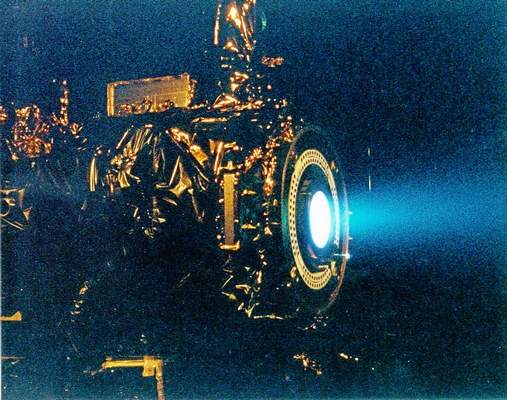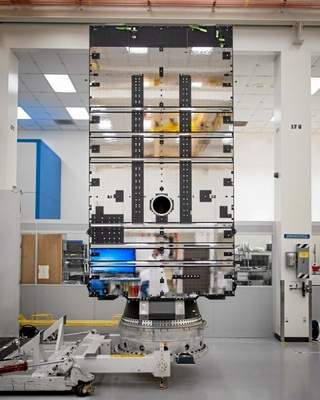.

An electric ion thruster is tested at NASA’s Glenn Research Center in Cleveland. Boeing has developed the first fully electric commercial satellite powered by a xenon-ion propulsion system, which works by charging heavy gas molecules and firing them at extremely high speeds. Nasa Photo
.
Boeing is on track to complete the world’s first fully electric commercial satellite, an innovation that will save telecommunications companies tens of millions of dollars per launch.
Electric satellites are only slightly cheaper to produce than traditional satellites but weigh significantly less, allowing launch providers to stack two satellites into one space pod and cut launch costs in half.
The immediate benefits of these smaller electric satellites are cheaper launches, but analysts say lighter propulsion systems will ultimately allow manufactures to build much more powerful satellites in the future.
Traditional satellites operate using hybrid technology. After a satellite is launched into space, it uses a liquid, chemical fuel-powered thruster to reach its final orbit position. Once in place, the satellite relies on solar-powered ion thrusters to tweak its position. Solar panels also power the satellite’s sensors.
But liquid-fuel rocket thrusters are very heavy, making up about a third of a satellite’s total weight. Fully electric satellites have no liquid fuel and rely solely on electric ion propulsion to reach orbit.
“It makes it very affordable for us to put a satellite into orbit,” said Ken Betaharon, chief technology officer at Asia Broadcast Satellite.
ABS has purchased the first of two fully electric 702SP satellites that Boeing expects to finish building later this year before sending them to Cape Canaveral, where Hawthorne-based SpaceX will stack and launch them on its Falcon 9 rocket in early 2015.
Betaharon said it costs ABS $175 million to $180 million to build, insure, and launch an electric satellite, much less than the $250 million to $275 million it would have cost for one with hybrid technology.
So why aren’t all satellite companies switching to electric?
The technology is new and relatively unproven, which means companies are skittish about using it to power their very expensive spacecraft.
Electric propulsion is also much slower than liquid fuel. It takes two to three weeks for a gas-powered satellite to reach its orbit compared to four to five months with ion propulsion.
“With electric propulsion, there is no free lunch,” Betaharon said. “You save a lot of the launch cost but you pay for the time it takes to get the satellite into geostationary orbit.”
Betaharon said that the conventional wisdom used to be that larger satellites brought down the per-sensor cost because of the economy of scale. The emergence of fully electric, stackable satellites has pushed the bigger-is-better logic “right out the window,” Betaharon said.
With six satellites in orbit, ABS is a relatively small satellite service provider that is more sensitive to cost than larger providers that may have reservations about fully electric propulsion, which has yet to prove itself, according to Roger Rusch, who runs the Palos Verdes Peninsula-based satellite industry consulting firm TelAstra Inc.
Rusch said satellite operators are starting to ask about all-electric designs but most aren’t ready to put their eggs in an untested basket. This is especially true in the case of fully electric satellite propulsion, which was attempted in the 1970s and ’80s with spotty results.
“When you have a new technology that’s had problems in the past, companies are reluctant to rely upon it exclusively,” Rusch said. “Companies like to have the confidence of the proven technology even if it’s not as efficient. If you have something and it fails and there’s no backup whatsoever, you’re going to be in difficulty right away.”
For companies like ABS, the discount afforded by going all-electric is worth the risk, and larger companies will likely follow, since the lighter technology will allow companies to build heavier, more complex satellites.
“Ultimately, if someone’s got a concept where they need to build a very big satellite that they wouldn’t have been able to launch before because it would have been too heavy, now they can do that,” said Tim Farrar, president of satellite consulting firm TMF Associates.
Until ion propulsion technology improves, however, it will continue to take months for all-electric satellites to arrive in orbit.
“It’s weighing the savings and urgency,” Farrar said. “If you’ve got to launch your satellite before the World Cup, you’re not going to be able to do it.”
.

Engineers work on the world's first fully electric satellite at Boeing's satellite factory in El Segundo. The first launch is slated for later this year.
Quelle: The Daily Breeze
